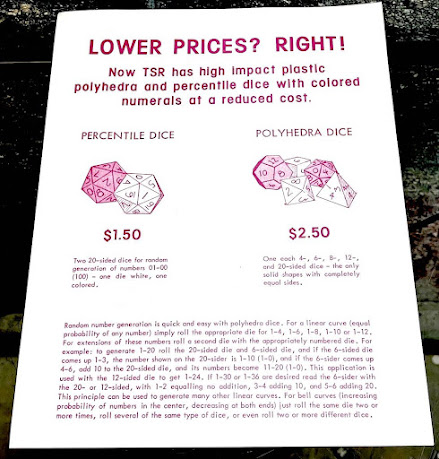The lengthy explanatory text at the bottom of the page especially caught my attention because it's extremely similar to the "USING THE DICE" section found near the end of the Holmes Basic rulebook. Back in the last post of the Holmes Manuscript series, I presumed that this section originated with TSR, as it is not found in Holmes' manuscript.
The above image is from a 2nd or 3rd printing of the rulebook, but the "Using the Dice" text is the same in the 1st printing. Below is a transcription in which I've bolded the text that is the same as in the "Low Impact" Ad:
Players need not be confused by the special dicecalled for in DUNGEONS & DRAGONS. By using theassortment of 4-, 6-, 8-, 12- and 20-sided dice, a widerange of random possibilities can be easily handled.For a linear curve (equal probability of anynumber), simply roll the appropriate die for 1-4, 1-6, 1 -8, 1-10 , or 1-12. If some progression is called for,determine and use the appropriate die (for instance, 2-7 would call for a 6-sided die with a one spot addition).For extensions of the base numbers, roll a second diewith the appropriately numbered die. For example: togenerate 1-20, roll the 20-sided die and 6-sided die,and if the 6-sided die comes up 1-3 , the number shownon the 20-sider is 1-10 (1-0), and if the 6-sider comes up4-6, add 10 to the 20-sided die and its numbers become11-20 (1-0). This application is used with the 12-sideddie to get 1-24. If 1-30 or 1-36 are desired, read the 6-sider with the 20- or 12-sided die, with 1 -2 equalling noaddition, 3-4 adding 10, and 5-6 adding 20. Thisprinciple can be used to generate many other linearcurves.For bell curves (increasing probability of numbersin the center, decreasing at both ends), just roll thesame die two or more times, roll several of the sametype of dice, or even roll two or more different dice.
The introductory sentence has been replaced with two sentences, and one extra sentence covering modified ranges has been added, but otherwise the text is almost identical. From this we can see how another portion of the text of the Holmes Basic rulebook was constructed from some pre-existing text. I don't know whether this text is original to this ad, or if there is yet another source text from which it was taken. I assume the author here is Gygax based on the lengthier "Dice" section in the AD&D Dungeon Masters Guide.
A later version of the "Using the Dice" text that is revised to include the chits can be seen in my recent post, Jim Ward on the Why of Chits.
See Also:
Dice of the Gods (Creative Publications Dice Packaging)
And Jon Peterson's numerous articles on RPG dice of the 1970s.


Ha, I always roll a sixer and 20-sided. But for some reason I got it somewhere that even on the sixer you add 10 to the 20-sided, and odd you do not. My friend Kevin was using the 1-3/4-6 method and I accused him of fudging his dice roll. Whoops!
ReplyDeleteThe even-odd method makes it easier if your d6 has pips, because on the even faces (2, 4, 6) there's no pip in the center of the die, and on the odd faces (1, 3, 5) there is a pip in the center. So I've always treated it as, "if the d6 comes up odd, you read that center pip as +10; if the d6 roll is even, just read the d20 as it lies."
DeleteAnother great find, Zach!
ReplyDeleteWonderful. I've noticed recently that the original dice sets themselves are fetching quite high prices.
ReplyDelete